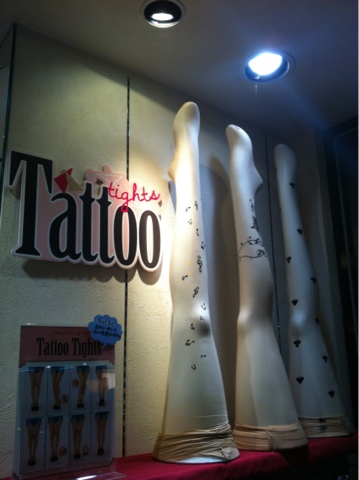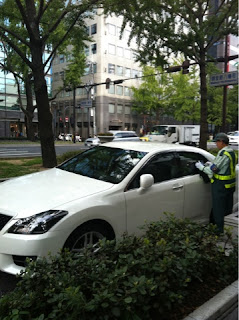So anyways back when I stilled lived in Korea and was in Japan on vacation, I visited Tokyo. And I did the thing that all people who come to Japan always talk about, especially where Akihabara is concerned, and I went to a maid cafe. It was called At Home Cafe, At Home Maid Cafe, @ Cafe or something along those lines. I remember they made a big-ish deal about using an at-mark, @. Possibly there was another similarly named one, or they thought themselves extra hip for doing that.
| ahhh that's the one. |
The place had possibly like 4 floors, each with a different theme, and I suspect a staff that rotated between them frequently (like every 2 hours). The reason for that is you don't want a creeper to get too attached to you, and therefore they is like a kind of safeguard against that. Of course, they can follow you to another floor, but then they would have to pay for everything all over again.
We chose a floor with their maids dressed as maids with added ears and tails for animal effects. Our server was a squirrel, but I kept calling her a fox. You had your dogs, cats, bunnies, tigers, and I remember there being a turtle too (sexy maid turtle...weird I know), I am sure there may have been others, just none that really stuck out. The place was pretty dimly light with a pretty modern design and use of colors. It was also very girly. In the front and center was a stage.
At first they explained to us that there was an entrance fee that would be added to our bill for going there. Like a club or a pet cafe or such. Our fee was 500 yen. Not too bad. They also explained that it was a timed affair. I am pretty sure we only had an hour for everything, but I would tend to think that it might also be standard to have 90 minute affairs as well (I say this because nearly everything here in Osaka has a 90 minute timer on things - buffets, all you can eat Brazilian BBQ, all you can drink things etc). After an hour is up, I expect you are expected to pay up or to likely pay again for another hour. So first they sat us down and then they came and gave me a welcome to Japan party baggie (it had a few stickers, a piece of candy and disposable chopsticks in it...). That was weird. They actually did have an English menu, which is proving his theory of gaijins frequenting maid cafes to be pretty accurate. We both ordered a parfait, which in Japan is a bowl of artful ice cream and fruit madness. They were huge. There were other things on the menu like coffee and om-rice and a few more pretty standard easy to make, no-effort kind of things as well (sandwiches and the like). And they do expect you to order something. You can't just go there and creepily stare at the girls for an hour. At least drink some coffee with that creepiness, man.
I am not really sure how often they do this, it could be every hour, or we could have just been lucky, but the stage got put to goo use. We had a Janken tournament (rock-paper-scissors). Sounds weird because it is. Basically, one of the ladies gets up on stage and does rock paper scissors with everyone. If you beat her, you can stay standing. If you lose, you sit yourself back down and enjoy that parfait. So as it happens, I was among the top 3 people. I also had no idea what I was doing, and my companion thought it was more amusing to watch me flounder a bit. So the maid gals came and got me and ushered me on stage and set me up with some tiger ears. The other two contestants were also there in some bunny and cat ears. They were male. And businessmen. Theory more and more correct. We three janken with the hostess and then I try to walk away. But no, apparently I won that round as well. I can't remember if I did or did, but I think they almost kept me up there for laugh value. Also for people to stare at something besides the men up there doing 'kawaii-kawaii-janken'. Oh and also worth a mention there was a chant and accompanying...motions... for this that they made me do as well. Faces can not turn redder.
I lost in the final round. The prize was to pick two girls to be taken in a Polaroid picture together with you. Actually, when we ordered, we ordered a set which was the parfait, possibly a drink?, and also a picture with a hostess. I think we could even pick which one if we wanted to because I remember them asking. I think the whole set cost perhaps 1500 yen? maybe it was 900? Either way, I remember it being more expensive then a cafe, but not super ridiculously priced. But apparently, you need to be careful with some places and over charging, and their sketchiness factor.
Right...the chant.... the chant went a little like this:
At home (but they are japanese and have to end things in vowels so it sounded more like ato homu)
*make right hand into a fist/circular fingers and the left hand just barely cover it...like an at-mark @*
Nya Nya
*a cat sound and you ball up your fists and hold them near your cheeks and rock them back and forward slightly when you say nya nya*
Joki Joki
*Joki is...I am not sure...but it symbolizes scissors, and you move your hands up to your ears and the same motions but with your fore and middle fingers make peace like scissors signs*
Wan Wan
* I am actually not 100% this is what they said, but it sounded like it and it was also what I chose to say(>.>). It would also make sense, seeing as if the first was a cat, the second is kind of similar to a rabbit, and this one would be a dog, as wan wan is the sound a dog makes in Japan. It was after all an animal themed maid cafe. So anyways, Wan Wan is for paper and you keep your hands by your ears and open your hands with fingers together and do the little up-down motion with them as you say it*
It all happens pretty quickly. So practice it so you are not unprepared.
| flyer girl advertising maid cafes on the street. |
Also worth a mention. You are not really allowed to take photos once inside the place. You might not even be allowed to take their photos on the street, but it is harder to stop you. The only picture I have of it, is the polaroid of the maid and myself. Also they take the time to draw all over the picture for you (hearts and things like 'love', 'kiss' and moe moe...whatever they things might be cute and pleasing to their customers). I will try to find and post the picture.














